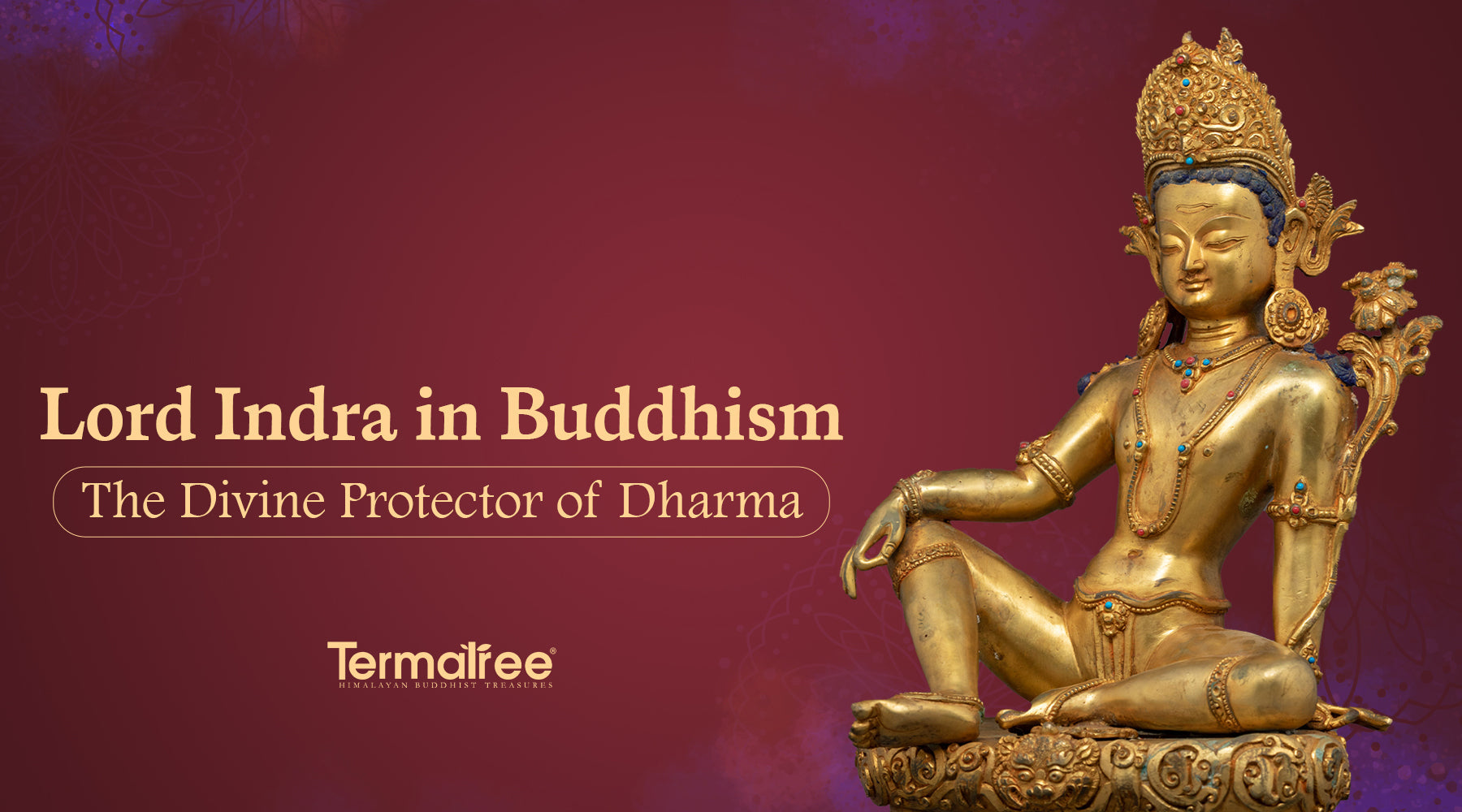Indra, The Ruler Of Trayastrimsa Heaven
Lord Indra, also called Shakra Devānām Indra or Shakra, is a central figure in the Rigveda, India's most ancient scripture. In Vedic mythology, he is the god of thunder, rain, and warfare. Buddhism, too, embraced Indra as its guardian deity, addressing him as Shakra or Indra in their texts. The Rigveda praises Indra as a formidable hero, with numerous hymns dedicated to his glory. He wields the mighty vajra, a weapon crafted by the divine artisan god Tvashtri.
Regarded as the King of Gods and the ruler of the heavens, Lord Indra, known as Sakra in the Vedas, commands the domains of rain and thunderstorms. His symbolic weapon, the Lightning Thunderbolt, referred to as Vajra in Hindu scriptures, symbolizes his divine might. Often depicted astride the celestial White Elephant, Airavata, Lord Indra enjoys the company of his holy mount, a vahana shared by many other gods in the Hindu pantheon.
Origin Of The Deity
The incorporation of pre-existing Vedic and Hindu ideas and deities into the early Buddhist cosmology and mythology is where Lord Indra first appeared in Buddhism. When Buddhism first appeared in ancient India in the sixth century BCE, the Vedic and Brahmanical traditions were already well-established in culture and religion. Many aspects of ancient traditions, including gods like Indra, were absorbed into Buddhist literature and thought.
Lord Indra in Buddhism

Click here to view our Lord Indra Statue
In Buddhism, Lord Indra is occasionally called one of the heavenly deities (often called devas or devaputras). Due to their celestial nature, these divine beings are thought to have a greater level of existence than humans, yet are subject to the cycle of birth and death (samsara). However, in Buddhist cosmology, they are not regarded as ultimate or eternal entities. Buddhism adopted Indra as its guardian deity, referring to him in their literature as Shakra or Indra.
Sakra is frequently shown as a devoted defender and promoter of Buddhism. Buddhist scripture claims that the Sakra played a crucial role when Gautama Buddha was meditating under the Bodhi tree by protecting him from a violent storm and offering offerings to the Buddha. The "Offering of the Milk Rice" is what this incident is known as, and it is a well-known tale in Buddhist folklore.
Ruler Of The Trayastrimsa Heaven
Buddhist cosmology divides the cosmos into various realms, including celestial realms. One of the upper heavenly realms, the Trāyastriṃśa Heaven, is sometimes linked to Lord Indra. Indra and many other holy beings who live blessed lives are thought to reside in this region. It stands for a higher plane of existence and is frequently pitted against the human world to emphasize how fleeting worldly joys are.
One of the most sought celestial regions is the Trāyastriṃśa Heaven, situated atop Mount Sumeru, the cosmic mountain in the center of the cosmos. As the monarch of this realm, Indra is one of the principal deities in Buddhist cosmology. The deity receives immense respect and power. His reign, characterized by wealth and morality, provides a window into the Buddhist cosmological cosmic hierarchy.
Iconography and Depictions of Indra The God
Vajra: The vajra (thunderbolt) is arguably the most well-known representation of Lord Indra. As the deity of thunder and rain, it represents his strength and authority. He uses a weapon that resembles a thunderbolt to command the forces of nature.
Elephant: Indra is occasionally shown riding Airavata, a white elephant. Given that elephants were frequently linked to monsoons, the elephant represents power, royal authority, and his relationship to rain.
Crown: To symbolize his position as the ruler of the skies and the lord of the gods, Lord Indra is frequently portrayed donning a royal crown.
Multiple Arms: Indra is frequently portrayed as having four arms, each holding a different symbolic object. These arms stand for his complex character and omnipotent power.
Lotus Flower: God Indra is sometimes depicted holding a lotus flower for spiritual enlightenment and purity.
Rainbow: The rainbow is frequently linked to Lord Indra because it is thought to have been produced by his divine bow or to have served as a sign of his presence.
Throne/ Chariot: He is occasionally seen sitting on a throne or driving a celestial chariot pulled by horses or, as previously indicated, an elephant.
Weapons: Indra is also connected with various weapons, such as the bow and arrow, which he uses to expel demons and uphold cosmic order, in addition to the vajra.
Peacock: The peacock is regarded as Lord Indra's chariot. It frequently appears with him in many representations.
Sacred Hymns: The hymns and prayers of the Rigveda are associated with Lord Indra in Hindu scriptures, and he is frequently seen holding or hearing them.
Royal Attire: Indra is frequently depicted sitting on a magnificent throne, donning royal attire, and sporting celestial jewelry to highlight his regal standing among the gods.
Indra Lord occasionally appears in Buddhist legends and Jataka tales (stories of the Buddha's previous lives). Celestial creatures like Indra are frequently used in these tales to teach moral and ethical teachings to the audience. The stories emphasize the transience of material success and the effects of one's choices.
The significance of Lord Indra in Buddhism is primarily symbolic and contextual. Despite his appearance in Buddhist writings and tales, his function is optional to Buddhism's fundamental principles and practices. Buddhism focuses more stress on realizing the causes of pain, finding a way to end suffering, and developing the virtues of wisdom, compassion, and moral conduct taught by the Buddha Siddhartha Gautama. Within the larger context of Buddhist stories and cosmology, Lord Indra's role is subordinate and performs particular functions.





